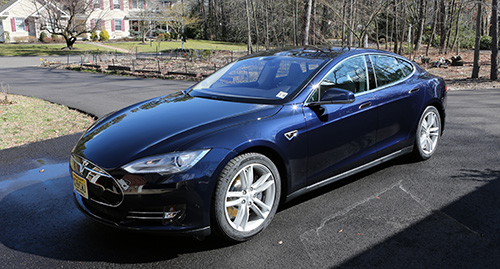5,000 Miles Without Fumes

Real World Environmental Impact
How efficient is a Tesla Model S? That was my primary concern when considering the purchase. Weather, temperature, elevation change, speed, and other driving habits all play into the picture. Tesla claims that you can get 300 miles per charge (283 wh/m) if you drive consistently at 55 mph, without climate control, and on a flat road. Given that I’ve never tried to do that, I can’t vouch for their statement. The EPA on the other hand estimates 269 miles per charge (316 wh/m). However, we’ve achieved 280 w/hr per mile since we first picked up our Tesla in March. That gives us an average range of 303 miles per charge in real world conditions.
Some might jump to the conclusion we are hypermilers. We are not. However, I have to say I don’t punch it as much as I did the BMW (my average mpg was 28). Just seeing the constant energy usage in the dash is a great reminder to drive more conservatively. A student of mine asked “Is it true when you get an EV you drive like a grandmother?” Sadly, there is some truth to that. I try not to drive much over the speed limit, I do accelerate slower than I used to, but the biggest issue is that my commute has a lot of stop and go traffic. If you do, and you use the regenerative braking (which engages when you release the acceleration pedal) and do not actually use your brakes, you gain a lot of energy back.
To date, we’ve never needed nor used a public charger. We simply plug in each night and wake to a fully recharged car ready to meet our needs. We didn’t opt for the high speed charger, because a 220 NEMA 14/50 plug which cost us $360 to install is plenty for our needs. We also only charge to 90% (as per Tesla’s recommendation) to improve battery life. On three occasions, when we had to drive over 200 miles, we did a complete 100% charge.
All is not as rosy as one would hope. The Model S draws power even when you are not using it. This is affectionately known as vampire power drain. Many devices act this way, however the Tesla is one big device. As such it drains 3-4 kw/h per day. We are told this is because the computers are all still on and running, but that this will be rectified with a software update this summer. Once that’s done it will have a huge impact on our efficiencies bottom line.
Our electric bill did go up, but because we have solar it’s hard to know exactly how much. We pay 16+ cents per kwh. One could calculate the amount of energy used and determine the cost. In doing so, you have to take into account that charging is never 100% efficient. In general, charging a Tesla is ~88% efficient. Therefore, our cost per mile =
Driving 4,994.8 miles (Tesla drove the first few) took 1,397.9 kwh. If I add 440 kwh (4 kwh per day for 110 days) and add 12% charging inefficiency the total kwh to charge the car = (1,397.9+440)*1.12 = 2,058.5 kwh. Our cost per kwh is approximately 16.5 cents/kwh. Therefore we paid $339.65 or 6.8 cents per mile to drive. Once the vampire drain issue is corrected, we would lose only about ½ kwh per day to vampire power. Therefore the charge needed would only be (1397.9+55)*1.12=1627.25 kwh. This would reduce our cost to $268.50 or 5.4 cents per mile to drive.
At $4 a gallon for gas, if we assumed 40 mpg a fairly efficient internal combustion car would cost 10 cents a mile to drive. However, if you compared the mpg of a BMW 5 series car at 28 mpg, the Tesla fairs much better than the 14.3 center per mile the BMW would cost. Part of the reason the savings isn’t more is that we have relatively expensive electric rates. At the national average of 11 cents per KwH the cost per mile with vampire drain is only 4.68 cents/mile or 3.7 cents/mile once we get the upgrade.
One last note of efficiency; these figures were for real world driving from the tail end of winter through the summer heat. The Model S seems most efficient around 75 to 80 degrees. In colder weather it was significantly less efficient as the battery and the cabin needed to be heated. In extreme heat, the car needed to be cooled, but didn’t require as much energy. In both cases, once the car warmed up or cooled down it returned to being efficient. Therefore, if you drive far all at once, it is more efficient than if you do lots of short trips with time in between each.
The story continues ...
